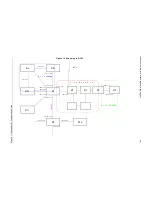
Chapter 12: Multicast Routing Configuration Guide
178
DIGITAL GIGAswitch/Router User Reference Manual
The GSR allows per-interface control of the host query interval and response time. Query
interval defines the time between IGMP queries. Response time defines the time the GSR
will wait for host responses to IGMP queries. The GSR can be configured to deny or accept
group membership filters.
DVMRP Overview
DVMRP is an IP multicast routing protocol. On the GSR, DVMRP routing is implemented
as specified in the
draft-ietf-idmr-dvmrp-v3-06.txt
file, which is an Internet Engineering
Task Force (IETF) document. The GSR’s implementation of DVMRP supports the
following:
•
The mtrace utility, which racks the multicast path from a source to a receiver.
•
Generation identifiers, which are assigned to DVMRP whenever that protocol is
started on a router.
•
Pruning, which is an operation DVMRP routers perform to exclude interfaces not in
the shortest path tree.
DVMRP uses the Reverse Path Multicasting (RPM) algorithm to perform pruning. In
RPM, a source network rather than a host is paired with a multicast group. This is known
as an (S,G) pair. RPM permits the GSR to maintain multiple (S,G) pairs.
On the GSR, DVMRP can be configured on a per-interface basis. An interface does not
have to run both DVMRP and IGMP. You can start and stop DVMRP independently from
other multicast routing protocols. IGMP starts and stops automatically with DVMRP. The
GSR supports up to 64 multicast interfaces.
To support backward compatibility on DVMRP interfaces, you can configure the router
expire time and prune time on each GSR DVMRP interface. This lets it work with older
versions of DVMRP.
You can use threshold values and scopes to control internetwork traffic on each DVMRP
interface. Threshold values determine whether traffic is either restricted or not restricted
to a subnet, site, or region. Scopes define a set of multicast addresses of devices to which
the GSR can send DVMRP data. Scopes can include only addresses of devices on a
company's internal network and cannot include addresses that require the GSR to send
DVMRP data on the Internet. The GSR also allows control of routing information
exchange with peers through route filter rules.
You can also configure tunnels on GSR DVMRP interfaces. A tunnel is used to send
packets between routers separated by gateways that do not support multicast routing. A
tunnel acts as a virtual network between two routers running DVMRP. A tunnel does not
run IGMP. The GSR supports a maximum of eight tunnels.
Note:
Tunnel traffic is not optimized on a per-port basis, and it goes to all ports on an
interface, even though IGMP keeps per-port membership information. This is
done to minimize CPU overload for tunneled traffic.
















































